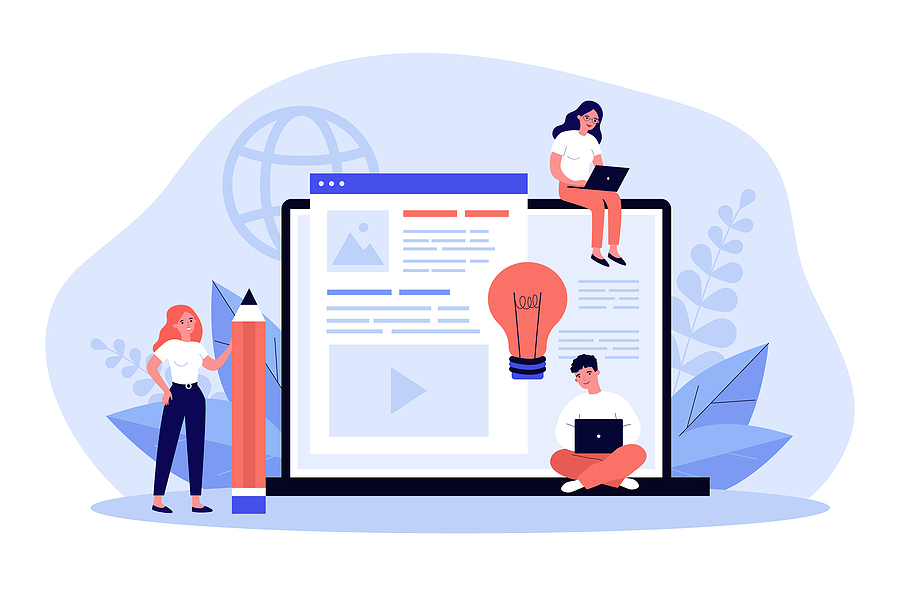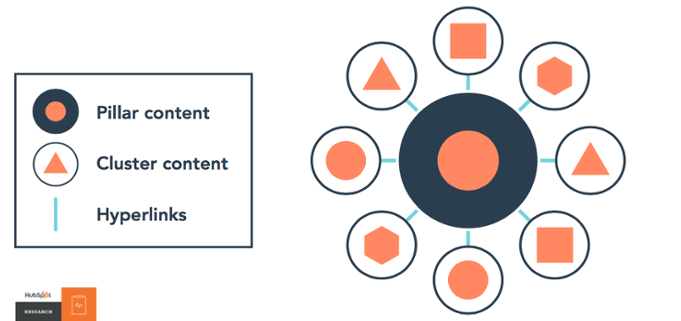
If there's one thing all digital marketing professionals can agree on, it's that site traffic is a key indicator of success. And as a key part of your site, your blog plays a big role in that. But how do you increase blog traffic for your business?
We took a page out of the books of SEO gurus everywhere to bring you the ultimate guide to increase blog traffic. If this quote from HubSpot is any indication, we've got a good bit of ground to cover:
"Search engines consider sites optimized for searchers to be fully optimized … by optimizing your website for the actual people coming to visit it, you’re killing two birds with one stone and simultaneously optimizing it for search engines."
Let's get started. Because this article is lengthy, we are providing an index:
Blogging is a critical component of any successful online marketing strategy. You've heard the phrase "content is king" before, no doubt. But why is blogging such an important part of a successful digital marketing strategy? What makes blog traffic so important?
First and foremost, updating your blog keeps your website fresh. If you produce and post content on a regular basis, you're signaling not only to your readers but also to search engines that you're keeping up with the latest trends. When you make sure to incorporate key search terms in your content, that's even better for search engines like Google.
Another key reason why blogs are so important is that they increase time on-page. When you're trying to increase blog traffic, time on-page is a key metric to look at. If you take the time to regularly update your blog with content you know your target audience is interested in, you're almost guaranteed a longer time on-page for each blog post.
Building up your blog also serves another purpose in the grand scheme of SEO: creating topic clusters. According to the pros at HubSpot, SEO is shifting to what they call a topic cluster model. In this model, one "pillar" page serves as the main hub for one overarching topic. Multiple content pages (blog posts) that are related to the main pillar page link to one another and back to the main page. This method of organizing the content pages on your site creates what HubSpot calls "deliberate site architecture." Essentially, your site looks cleaner and you're building more relevant links within your site in the process.

The more you incorporate strategies like topic clusters into your site's content, the more likely you are to see a greater connection between your blog and your overall site traffic. And that's precisely what blogging does for your site as a whole -- it draws traffic. Let's explore how.
When you think about the ways people can find your website, it boils down to three basic options. They could type your site right into your browser, but that's dependent on an audience that already knows who you are. You could opt for an email marketing campaign and hope people click through your links. And finally, you could embark on a paid ad campaign. The issue with the last option is that it’s expensive. Essentially, it's "coin operated.” Your traffic stops when you reach your budget, which isn't a very sustainable marketing strategy. However, there are strategic reasons to add a paid advertising campaign to your marketing programs. We will cover that in another article.
As you assess whether paid ad or email campaigns are right for you, it's important to hone other aspects of your online marketing strategy. That's where blogging comes into play. When you create blogs on a regular basis, you're ensuring that pages are consistently being added to your site and indexed on key search terms. Blogging is a great way to incorporate long-tail keywords into your content, which in turn can help you gain more SERP visibility. When your content ranks for a long tail keyword -- one that does not generate many visits but is highly targeted to the problems your ideal customer has -- then you have created a traffic set for your website of best fit customers. It only takes a few of them to convert into leads for that content to have paid off.
Not only does blogging help you keep your site updated and toward the top of search engine results, but it also provides excellent fodder for social media. When you have 800 to 1,000 words of content in a blog post, you're creating an arsenal of snippets for your social media accounts. Repurposing your content for different social media networks is a great way to expose new audiences to your site.

You know why blogging is important when you want to increase traffic to your site. But how do you go about creating a blog that contributes to better traffic?
A truly great blog accomplishes a few different things. First and foremost, a great blog will align business objectives with user intent. When it comes to blog quality, you simply can't define it in isolation. Quality, where digital marketing is concerned, depends on your business goals and your target audience's needs. If your content doesn't contribute in some way to your business goals or give readers what they need, it's going to be tough to classify it as high-quality.
When you create blogs for clients, they are defined as part of a content strategy which identifies the problems a company's clients are facing and how to solve them. These topics create great long tail search rank directly linked to the customers' business objectives so they find you when they need your help. So before writing your next blog, remember to ask yourself the following questions:
Specificity is your friend when you need to create awesome content for your site. Once you've answered the above questions, you need to hone in on a specific topic. Great content focuses on one specific topic in great detail. This doesn't mean that every blog needs to be 2,500 words long, either. If you can cover a specific topic in detail with 1,000 words, go for it. The key is creating meaningful, informative content for your readers.
Your blog's formatting is also going to play a key role in how much time your readers will spend with it. The easier it is for readers to glean information from your blog, the more likely they are to spend time reading it. Some key formatting elements to incorporate into your blog include:
Paired with a conversational tone that makes your readers feel like they're in the room with you, these formatting elements will help you create blogs that captivate readers. And as we mentioned earlier, a great blog will align your business objectives with readers' needs.

It's also a good idea to understand what types of blogs typically earn the most traffic. HubSpot cites three distinct types of blog content that have high referral traffic:
Why do these blogs earn so much referral traffic? The one thing each of these content types have in common is research. A well-researched blog with citations from an expert in the field can work wonders for your content's credibility. Not only will you have a well-researched piece that you can be proud of, but you'll also be providing valuable information to your readers.
Once you've mastered the art of creating engaging content for your site, it's time to address the issue of how to increase blog traffic. One of the biggest mistakes that marketers make when it comes to creating content is "they invest 90% of their resources in production and only 10% on promotion," according to Irina Nica, one of HubSpot's Senior Marketing Managers of Product Awareness. So let's talk about promotion.
The first way to promote your content is to create content worth promoting. When you target your content toward an audience that's already likely to link back to it and share it, then you're on your way to content promotion success. But it's not enough to let your audience come to you in most cases. That's why you need to go to your audience. Participating in reader communities (social media, forums, etc.) is a great way to get your content out to audiences who want to read it. Once again, content becomes fuel for your social media. Share snippets or ask for readers' opinions on different social media platforms. The more well-crafted your content is, the more engagement it's likely to get.

Interacting with your audience is one of the key ways to promote more engagement with your content. Whether you're answering questions about your content on social media or sharing blogs on relevant Reddit forums, the way you use content to interact with your readers is key to good promotion.
While we're on the topic of sharing content, let's talk about how graphics play a role in content promotion. Readers are much more likely to click on a social post if there's a catchy image or graphic attached. To that extent, don't forget graphic design as part of your promotion strategy. Infographics that summarize important points from your content make for excellent promotion fodder.
Above all else, focus your promotion efforts on link building. Using the content creation tips we covered above can help you create content that people want to link back to, but your promotion efforts will also help with your backlink strategy. While part of this does encompass encouraging others to build links to your blog, you can't discount the importance of link building within your own site. This type of link building builds on the topic cluster organization method we covered earlier.
Creating great content and devising strategies to promote it are both important if you want to increase blog traffic, but equally as important is learning how to track your traffic.
There are a few different sources of traffic that you need to pay attention to as you begin to track them.
These four types of traffic are the most important and the most likely to affect your site if you're not relying on email marketing or paid search. Direct traffic is perhaps the rarest because it comes from people who already know your site and go directly there. If you have direct traffic to your site, it's likely from people who have already established a relationship with your content.

Organic traffic, on the other hand, comes from search engines and is largely a result of how well your content is optimized. Those long-tail keywords you incorporated into your content are going to pay off in this regard.
Social and referral traffic are equally as important because they come from sites other than your own. This is the result of your link building strategy and promotion plan coming to fruition.
If you're not sure which type of traffic to place emphasis on, go for organic and referral traffic first. These two types of traffic often come with the biggest results and may convert visitors into genuine leads for your business.
Our first tip is to use the tools available to you. Make sure you have analytics installed on your site so you can take a look at how many visitors you're getting. It's also possible to use third-party analytics tools to look at how your traffic is performing over weeks and months.
In addition, you'll want to track how different content performs on your site when it comes to traffic. Why did one blog have five times as many visitors as another posted a day before? Tracking your traffic can help you better understand what your readers are looking for and how you can give it to them.
Most businesses add Google Analytics to their site to learn the origin of traffic and which pages generate the most traffic. Many website hosting platforms like Hubspot CMS also provide a full suite of built-in analytics so you can measure everything from traffic sources to page performance, conversion rates, and more.
Once you begin tracking traffic to your blog, you'll likely find that keeping it is your next big challenge. The key here is a willingness to learn.
When you're tracking your blog traffic, you might see that some posts aren't performing as well as others. This might seem like a failure at first, but it's really an opportunity for you to learn. It could be time to restructure your posts! Doing so can help you keep your current traffic and even grow it. A few key things to check include:
Understanding your audience's behavior is critical if you want to keep them coming back to your blog for more content. It's also worth considering accepting guest posts on your site. In doing so, you could open yourself up to an entirely new audience. Guest post exchanges mean that you can put your content in front of an audience of readers you might never have been able to reach otherwise.

As we mentioned earlier, expert interviews have some of the highest traffic rates of any kind of blog. Peppering in some expert interviews or guest posts not only gives you new opportunities for backlinks, but it also gives your readers something new to engage with.
If you want to increase blog traffic, it's key to understand how fundamental good content is to online marketing. Once you have that down, it becomes a matter of understanding your audience, tracking your traffic, and maintaining it.
Have questions about how to best optimize your blogs or get more traffic to your site? Don't hesitate to ask our experts today.
An easy way to get started is to:
If you find Search Engine Optimization confusing, you always can reach out to a company that offers services to help you improve the overall performance of your website. Of course, Bristol Strategy offers SEO as part if our Inbound Marketing and Website services. Click on the image below for a white paper that describes the 17 SEO myths to leave behind when working on your next blog or website page development.
Bristol Strategy is a full funnel inbound marketing agency and inbound sales agency offering the full complement of services to enable our clients to surpass their business objectives by transforming the way they engage with their buyer on-line. Reach out to us to learn more about how our experience and capabilities can help your business grow.
Ask us about our unique approach that creates a full-funnel "inbound" engagement model for your business that attracts and converts digitally engaged prospects.